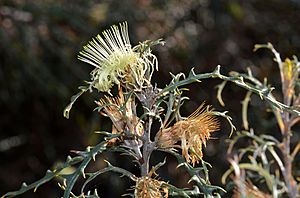Banksia hewardiana facts for kids
Quick facts for kids Banksia hewardiana |
|
|---|---|
 |
|
| Scientific classification | |
| Genus: |
Banksia
|
| Species: |
hewardiana
|
| Synonyms | |
|
|
Banksia hewardiana is a type of shrub that grows with many branches. It is found only in Western Australia. This plant has long, saw-edged leaves with sharp teeth. It also has groups of up to sixty bright lemon-yellow flowers and oval-shaped seed pods called follicles.
Contents
About the Banksia Hewardiana Plant
Banksia hewardiana is a shrub with many open branches. It usually grows to be about 0.5 to 3 meters (1.6 to 9.8 feet) tall. This plant does not form a special woody lump at its base called a lignotuber.
Leaves and Flowers
The leaves of Banksia hewardiana are long and thin, like a line. They are 40 to 200 millimeters (1.6 to 7.9 inches) long. They are also 10 to 24 millimeters (0.4 to 0.9 inches) wide. Each leaf has a short stem, called a petiole, up to 5 millimeters long.
The edges of the leaves are serrated, which means they look like a saw. Each side of a leaf has between five and fifteen sharp, pointed teeth.
The plant produces groups of 35 to 60 flowers. These flowers have a sweet smell. They grow in a cluster, or "head," on a side branch that is about 20 millimeters (0.8 inches) long. At the bottom of each flower head, there are small, hairy, spear-shaped leaves called involucral bracts. These bracts can be up to 10 millimeters (0.4 inches) long.
The flowers themselves are lemon-yellow. The main part of the flower, called the perianth, is 21 to 26 millimeters (0.8 to 1.0 inches) long. The female part of the flower, called the pistil, is cream-coloured. It is 23 to 27 millimeters (0.9 to 1.1 inches) long and smooth, without hairs.
Flowering and Seeds
Banksia hewardiana flowers from July to November. After flowering, the plant produces seed pods. These pods are called follicles. They are oblong or egg-shaped. Each follicle is 8 to 10 millimeters (0.3 to 0.4 inches) long. They have a few hairs on them.
How Banksia Hewardiana Got Its Name
This plant was first officially described in 1856. A scientist named Carl Meissner gave it the name Dryandra hewardiana. He published his description in a book called Prodromus Systematis Naturalis Regni Vegetabilis. Meissner studied plant samples collected by James Drummond.
The second part of the plant's name, hewardiana, honors an English botanist. His name was Robert Heward (1791–1877).
Later, in 2007, two other scientists made a change. Austin Mast and Kevin Thiele moved all plants in the Dryandra group into the Banksia group. This is why the plant's name changed to Banksia hewardiana.
Where Banksia Hewardiana Grows
Banksia hewardiana is found in Western Australia. It grows in areas with woodlands and heathlands. These are places with many trees and shrubs. You can find this plant between the towns of Cataby, New Norcia, and Moora.
Conservation Status
The Government of Western Australia's Department of Parks and Wildlife has looked at Banksia hewardiana. They have classified this banksia as "not threatened." This means the plant is not currently in danger of disappearing.

